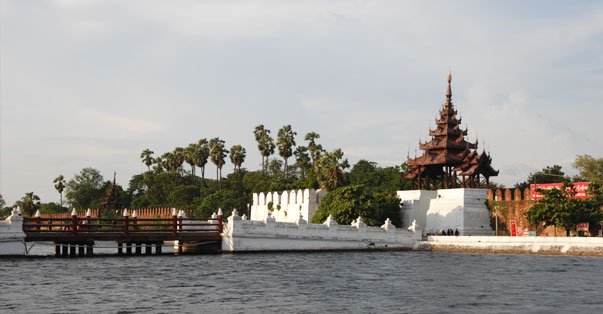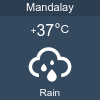Mandalay
Mandalay
- Details
- Last Updated: 14 November 2018
- Hits: 48516
 Mandalay
Mandalay
History of Mandalay
Mandalay (မန္တလေး), as the center of Myanmar culture, was outstanding in the past, and it will continue to be a place of pride of Myanmar in the future.
It is situated about 600 kilometers north of Yangon on the Ayeyarwaddy river, with a population about half a million, making it Myanmar's second largest city.
Mandalay is the historical old capital, a capital of Myanmar culture, Buddhist Sasana and Myanmar traditional arts and crafts, with the life span of one hundred and forty two years, a city which abounds in historical sites, cultural memorials and Buddhist edifices. Accordingly, it is the richest historical landmark next to Bagan.
Despite the wonderful sound of its name, inviting associations to an archaic fairy tale kingdom, Mandalay is neither very old nor particularly beautiful. But Mandalay was the capital of the last, independent Burmese kingdom, which in 1886 was finally conquered by British colonial forces.
The town had been founded only 29 years earlier in 1857 by King Mindon, making it the capital of an independent kingdom for less than 30 years. In 1857 Mandalay was set up in an empty area, because, according to an ancient prophecy, in that exact place a town would come into existence on occasion of the 2,400th jubilee of Buddhism.
The city was named after the Mandalay Hill, which is situated at the northeast corner of the present city. The hill has for long been a holy mount and it is believed that Lord Buddha prophesied that a great city, metropolis of Buddhism, would be founded at its foot. It was King Mindon who fulfilled the prophecy.
King Mindon decided to fulfill the prophecy and during his reign in the Kingdom of Amarapura he issued a royal order on 13 January, A.D 1857 to establish a new kingdom. The Ceremony of Ascending the Throne was celebrated in July, 1858. The royal city and the kingdom was demarcated. The whole royal city was called Lay Kyun Aung Mye ("Victorious Land over the Four Islands") and the royal palace, the Mya Nan San Kyaw ("The Royal Emerald Palace"). The kingdom was called the Kingdom of Yadanabon, along with other name Ratanapura, mean " The Bejeweled Site ". Later it was called Mandalay after the Mandalay Hill, 2.5km far to the north east of the royal palace, and today the name still exists. The name " Mandalay " is a derivative of the Pali word " Mandala ", which means " a plainsland " and also that of the Pali word " Mandare ", which means " an auspicious land ".
At that time a transfer of the capital not only meant leaving an old town and erecting a new town in a different place. As all secular buildings of that time, including the royal palaces, were built from wood, a transfer of the capital meant the complete dismantling of the houses of the old settlement, which then were loaded on carts and the backs of elephants to be reconstructed at the place chosen for the new town.
But in 1782 the town was packed up and moved about 8 kilometers to the Northeast, to the aforementioned Amaraputra. In 1823 the entire capital was dismantled again and rebuilt 8 kilometers Southwest in Ava. But in 1838 Ava was damaged by an earthquake, and was therefore in 1841 packed up again and once more transferred to Amarapura. But this was not of duration either, as only 16 years later the entire town was moved again this time 12 kilometers to the Northeast to the present Mandalay.
The rhyming couplet easy to memorize the year of building the royal city is " Okkyit-Kyaw Aye / Mandalay " or " Aung Kyaw Chan Aye / Mandalay " ( i.e, M.E 1221 ). The city's layout of the construction is the same at that of the earlier Kingdom of Amarapura, and from the bird's eye-view, it has the structure of geographical squares and rectangular shapes, with streets and roads crossing one another at right angles. There are four parts dividing the city, namely, Ashe-pyin ( East Part ), Anok-pyin (west Part), Taung-pyin (southern part) and Myauk-pyin (Northern Part), with 54 plots.
With the Ground-breaking ceremony, King Mindon laid the foundation of Mandalay on the 6th waning day of Kason, M.E 1221, (A.D 1857). The King simultaneously laid the foundations of seven edifices: the royal city with the battlemented walls, the moat surrounding it, the Maha Lawka Marazein Stupa, the higher ordination hall named the Pahtan-haw Shwe Thein, the Atumashi ( the Incomparable ) monastery, the Thudhama Zayats or public houses for preaching the Doctrine, and the library for the Buddhist scriptures.
At the time of building, the royal moat was 68.58m wide and 3.35m deep, and was fed with water from the Yadana Nadi, now called the Ye Ni Canal. In 1995 the moat was dug anew and the banks were laid neatly and firmly with rocks. There existed 20 gardens, a huge earthen wall and 57 doors palace. There existed 5 bridges spanning over the moat and 12 bridges. At present, there are four spanning bridges, namely the U-hteik Bridge to the east the Kyaw Moe Bridge to the south, the Kye Mon Bridge to the west and the Lay Thein Bridge to the north.
When King Mindon passed away, his son King Thibaw ascended the throne, and in M.E 1247, Myanmar fell under the British colony. It was the old capital ruled by two successive kings the one where the last of Myanmar's monarchs reigned.
After the British had conquered Mandalay in 1886 they turned the royal palaces of Mandalay into their military headquarters and christened the complex Fort Dufferin.
During World War II the Japanese installed a military camp in the same place, which then was bombed by the allies, until nothing was left of the ancient palace buildings.
Mandalay today is a striking phenomenon composed of modern and classic images with the ancient cultural beauty of the royal palace and the moat surrounding it, and the natural impressionistic beauty of the Mandalay Hill, harmoniously added with new architectural phonography of modern houses and brick buildings.
The former palace ground is known by the name of Fort Mandalay. Of the ancient palaces a few concrete replica have been built and further reconstructions are being conducted.
Mandalay is full of variety to do shopping. The new Mandalay Zaycho is the main market place in Mandalay. You can get almost anything from there. Things to shop are Acheik (Mandalay Silk Longyi), Cotton clothing, Hto Moat (greasy cakes), Laphet (Pickled tea leaves), Kadipar slippers (Velvet Slippers), Silverware, Lacquerware, Jewelry, gems and more.
Air
There are daily flights from Yangon to Mandalay via Air KBZ, Air Mandalay, Yangon Airways, and Myanmar Air. Mandalay now has an International Airport, so there are also flights from other countries directly landing to Mandalay.
Bus and Express
There are daily local express from Yangon to Mandalay and many other parts of the country.
Taxi
Pickups and vans are available to travel around Mandalay, Amarapura, Inwa, and Sagaing.
Train
Mandalay has a new Yadanarbon Central Railway Station in downtown area. It is a seven-storey complex, including two floors devoted to a hotel. The old station is on the further south of the new one. There are daily schedules from Yangon to Mandalay.
Motorbike
Motorbikes can be seen everywhere in Mandalay. Travelling by motorbike can be very convenient in local places. So, motorbikes can be rented mostly everywhere in Mandalay.
Boat
The Inland Water Transport office is located at the Gawwein Jetty at the western end of 35th Street.
Bicycle
There are several places downtown where you can rent bicycles.
Entertainment
Mandalay is a busy city which is the central trade centre of Myanmar. There are cinema halls, beauty salons, spas and karaoke lounge in the most populated part of the city. There are also many well-known astrologers and palmist in this city.
Food
Mandalay is a city with great historical heritage. Many traditional food can be tasted in this city.
Founded at 1857
Founded by King Mindon
Fell under British Colony at 1885
Mandalay being the second largest capital of the State, in accordance with the times of building a peaceful, modernized and well developed new future State, emphasis has been given to enhance the role of information media.
Media
The city dwellers can enjoy listening to the radio progammes broadcast by M.B.S and watching the TV channels of MRTV and the Myawaddy. The newspapers the Light of Myanmar and Kye Mon are published and distributed by the presses of Mandalay for Upper Myanmar.
City Development
Mandalay City Development Committee has organized Public Relations and Information Department, and has been increasing the momentum for the progress of the information media. Mandalay Daily is published as the Mandalay-centred, Upper Myanmar supporting media and representative media of the State. The Mandalay Daily Press is situated on 29th road between 73rd road and 74th road. Through this press media, the State Policies, and feature articles, as well as the objectives, performances, activities, information and feature articles about M.C.D.C, are presented to the public unfailingly and in time.
The Mandalay City Development Committee has published the pamphlets, namely, Mandalay City Profile, Mandalay City Map and Welcome to the Golden Palace City, which will inform the foreign visitors about interesting facts and functions of Mandalay. It is a press media which will send good news through foreign visitors to the World. Moreover, Mandalay Directory is published in both Myanmar and English Versions annually, which contain information about Mandalay City Map, offices, departments, organizations, factories and industries, companies, stores, markets and hospitals and clinics, businesses, location and phone numbers.
ICT Development
Mandalay ICT Development Corporation Ltd is located at Third Floor, Yadanarbon Zay in Mandalay. Mandalay ICT Development Corporation, a consortium of (50) local companies with the full support from the Government of the Union of Myanmar, initiated the Mandalay ICT Park project with the aim of creating an ICT hub for upper Myanmar.
It is part of the ICT master plan of Myanmar to stimulate the development of Myanmar ICT industry by attracting local and international partners to form a cluster of ICT - Related Business, supported by world-class infrastructure and technologies.






